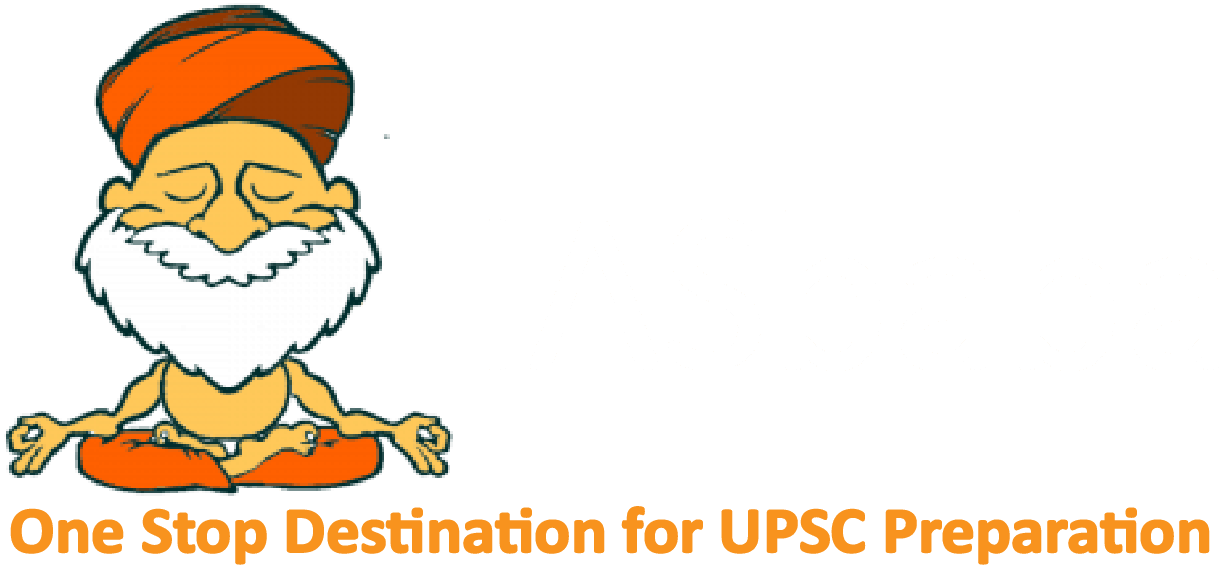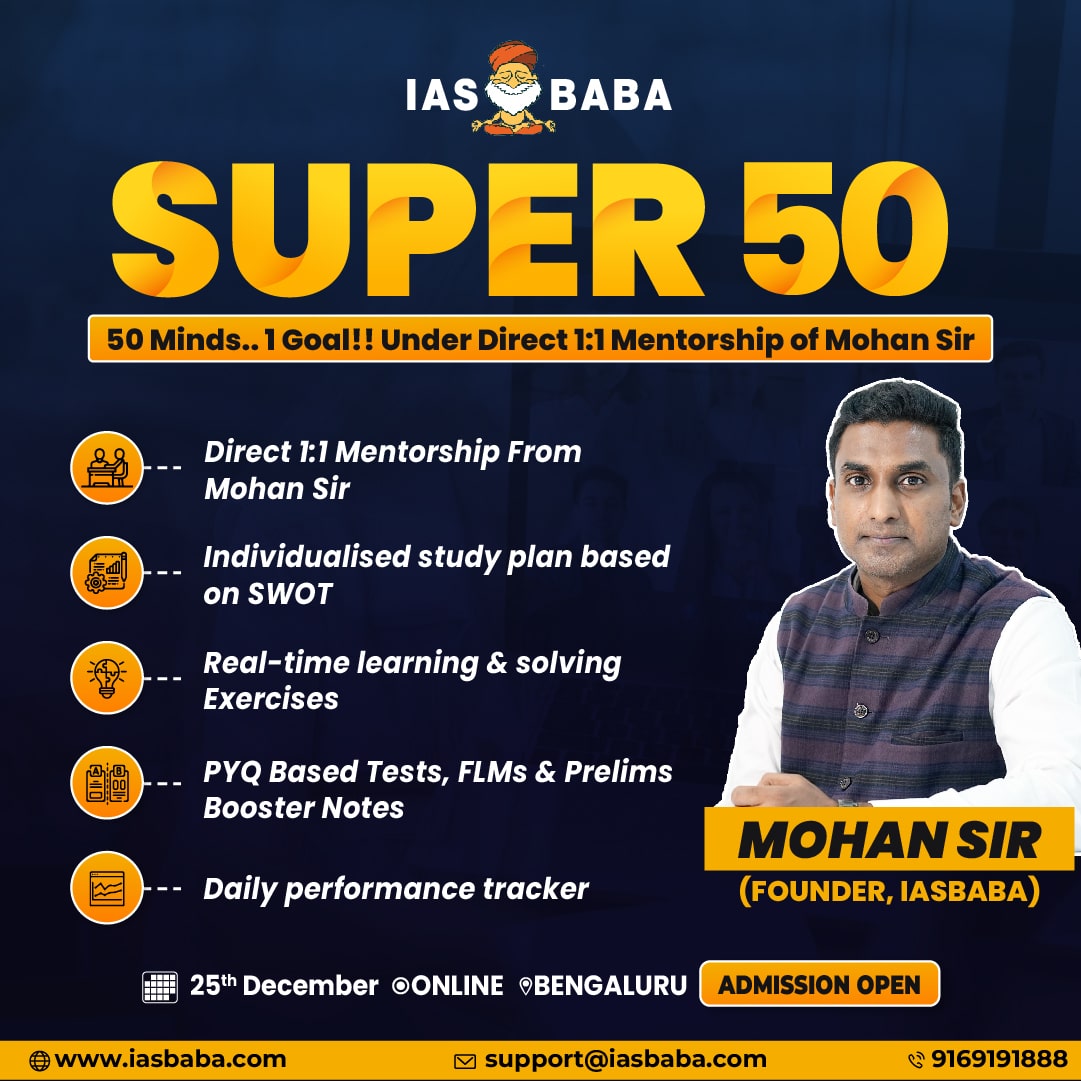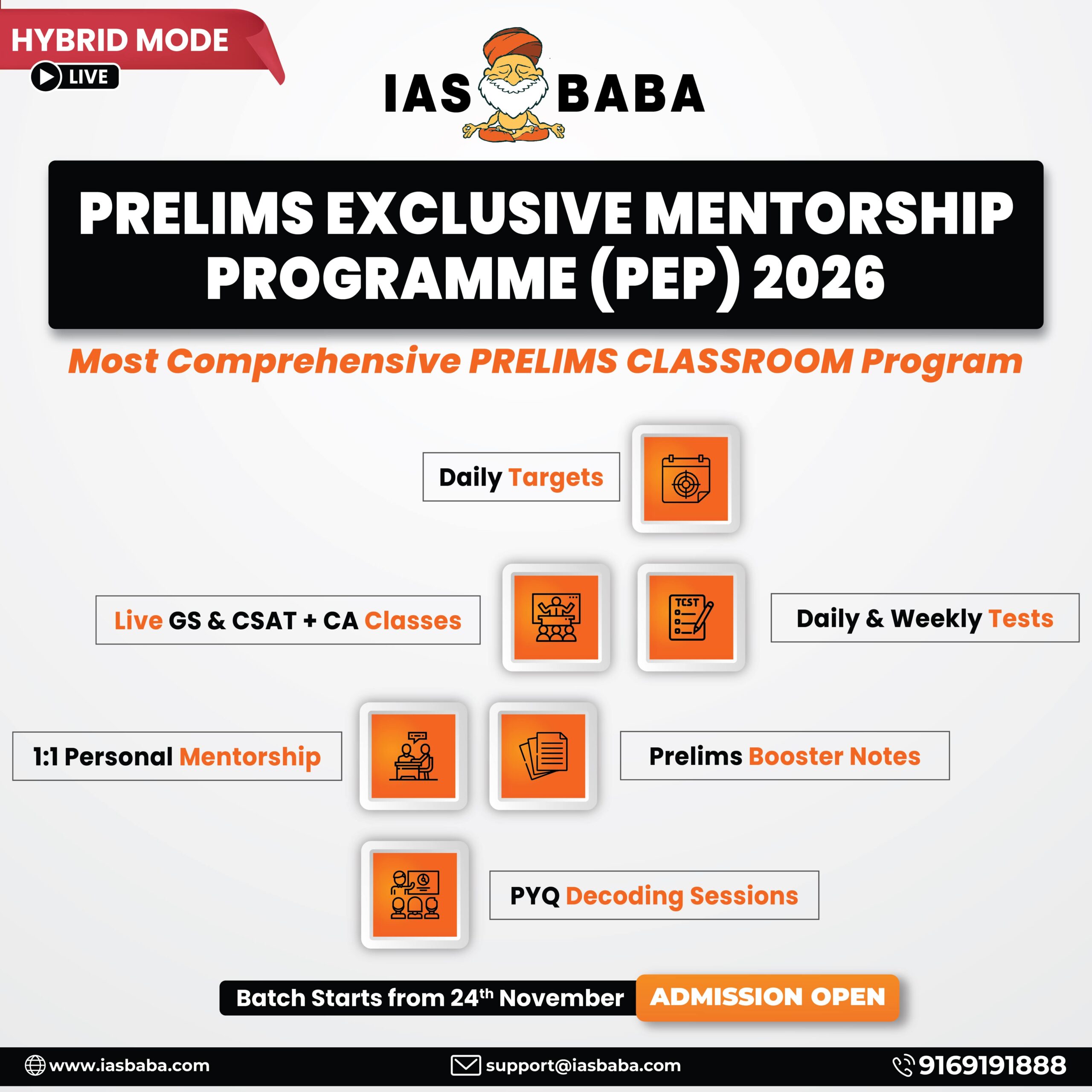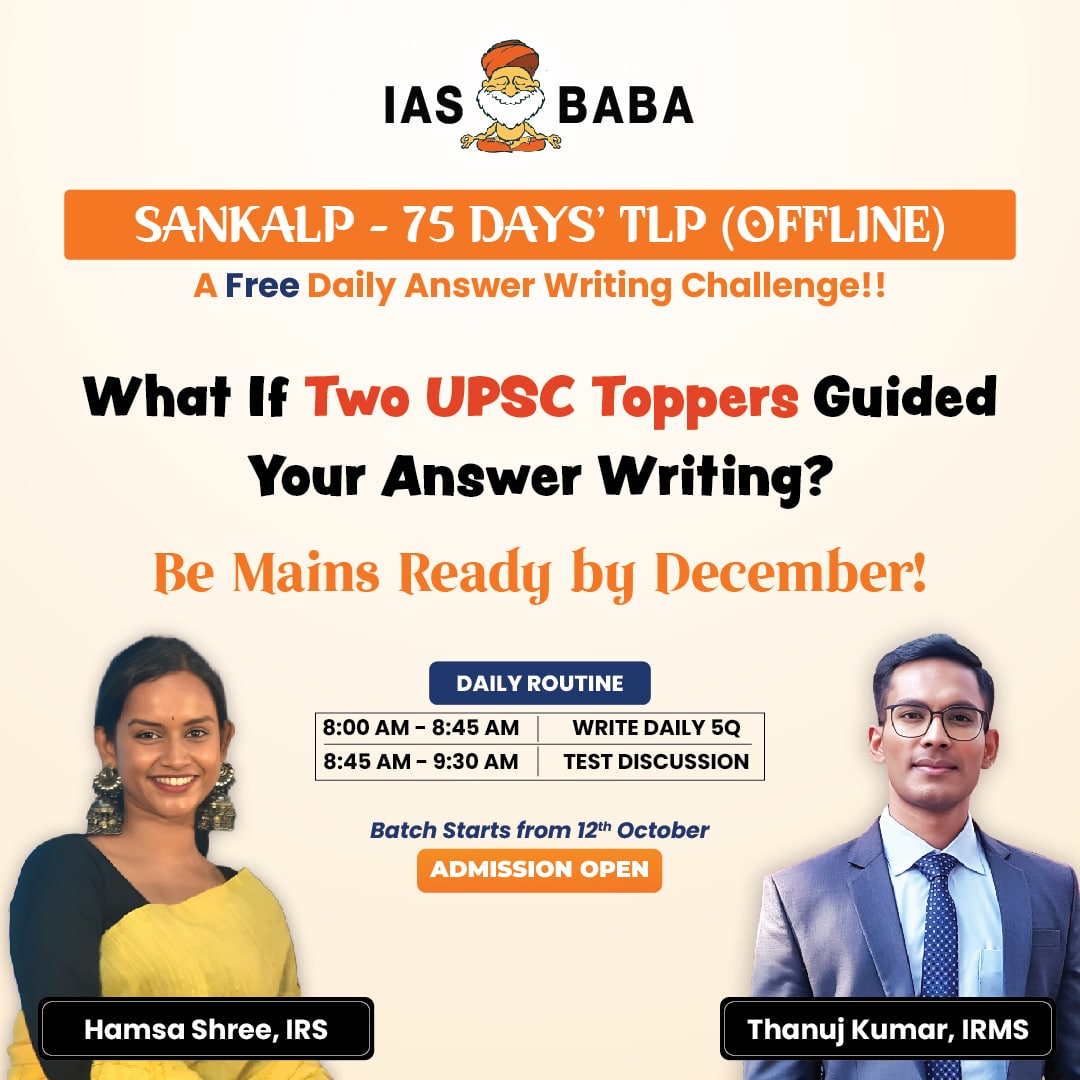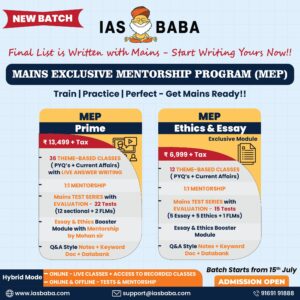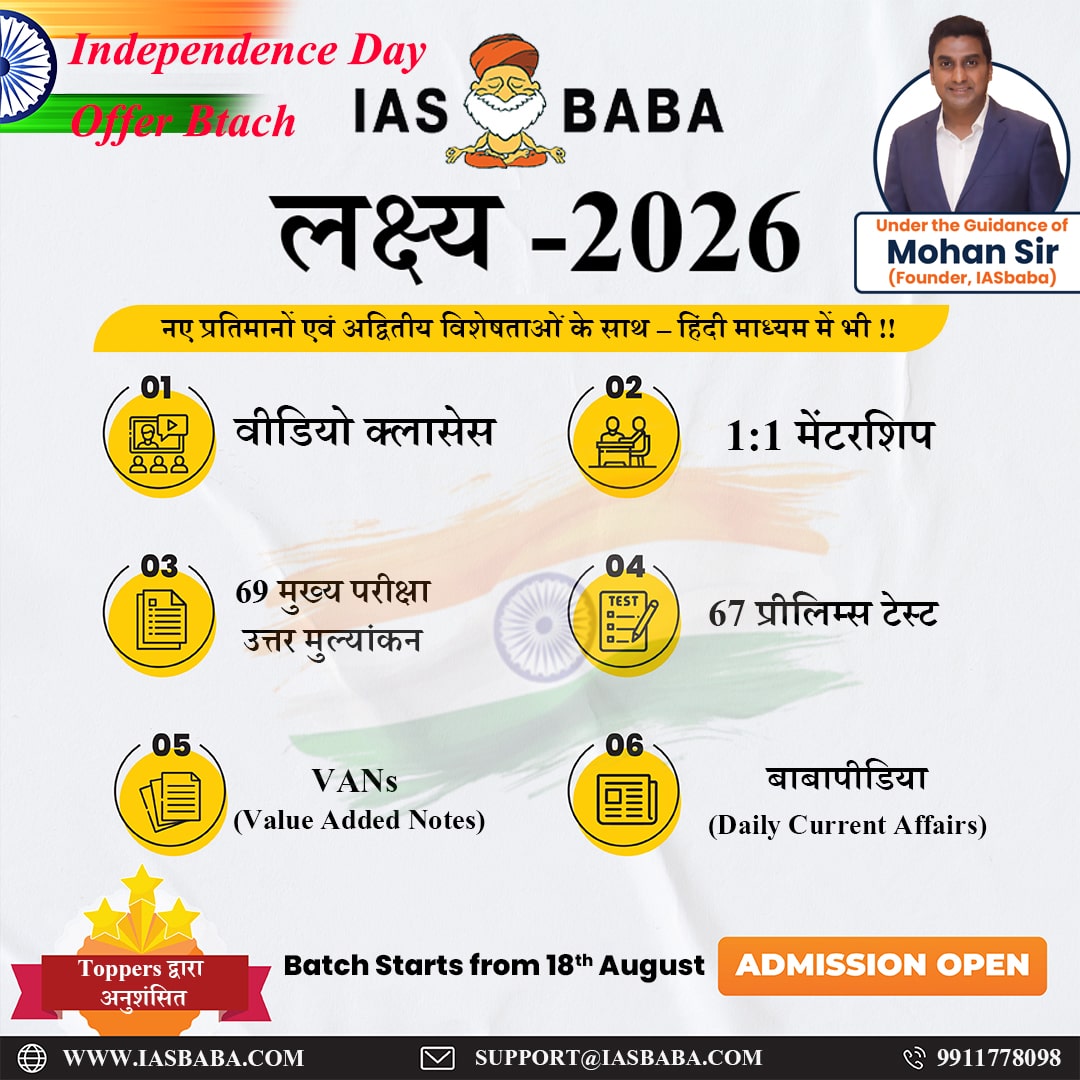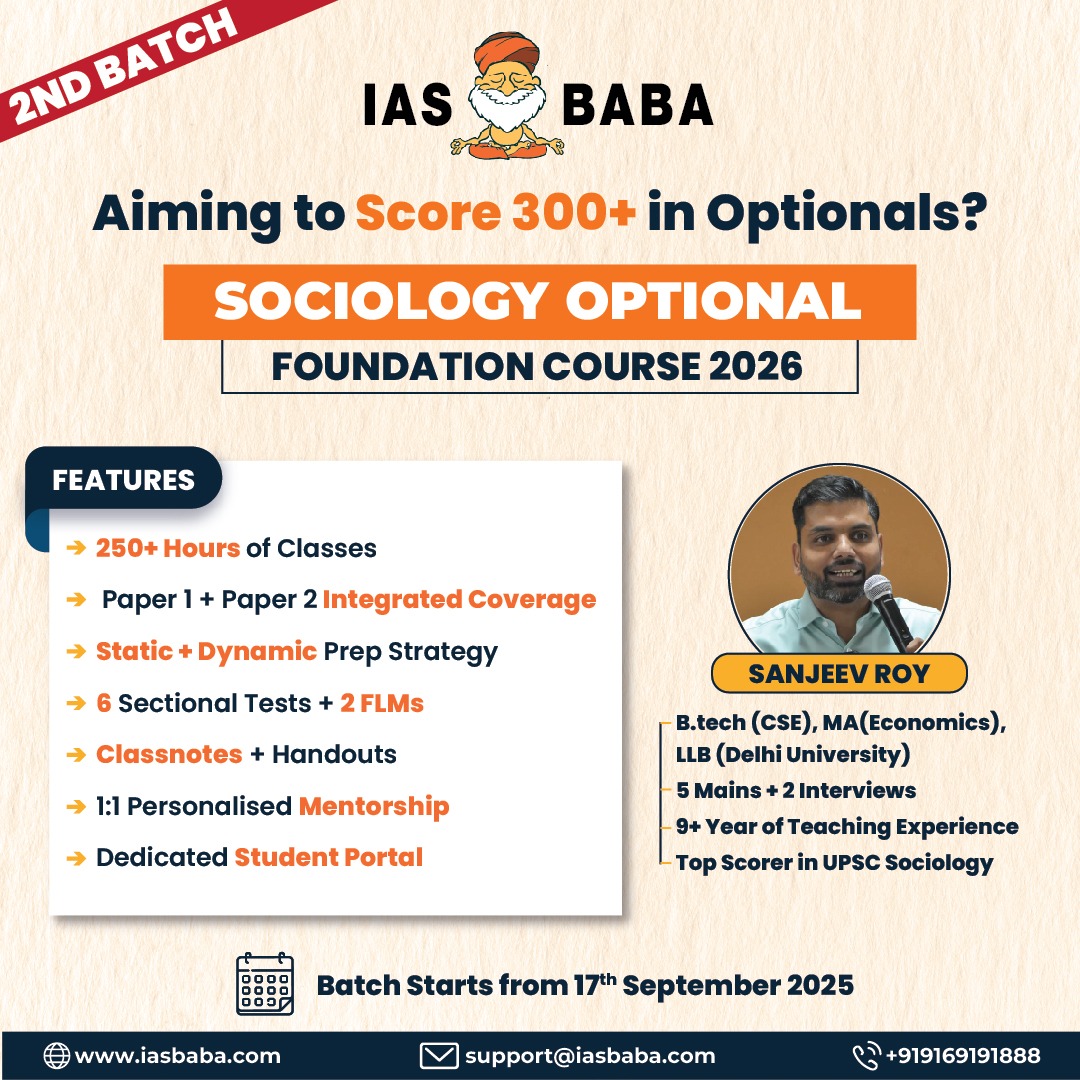IASbaba Prelims 60 Days Plan, Rapid Revision Series (RaRe)
Archives
Hello Friends
The 60 Days Rapid Revision (RaRe) Series is IASbaba’s Flagship Initiative recommended by Toppers and loved by the aspirants’ community every year.
It is the most comprehensive program which will help you complete the syllabus, revise and practice tests on a daily basis. The Programme on a daily basis includes
Daily Prelims MCQs from Static (Monday – Saturday)
- Daily Static Quiz will cover all the topics of static subjects – Polity, History, Geography, Economics, Environment and Science and technology.
- 20 questions will be posted daily and these questions are framed from the topics mentioned in the schedule.
- It will ensure timely and streamlined revision of your static subjects.
Daily Current Affairs MCQs (Monday – Saturday)
- Daily 5 Current Affairs questions, based on sources like ‘The Hindu’, ‘Indian Express’ and ‘PIB’, would be published from Monday to Saturday according to the schedule.
Daily CSAT Quiz (Monday – Friday)
- CSAT has been an Achilles heel for many aspirants.
- Daily 5 CSAT Questions will be published.
Note – Daily Test of 20 static questions, 10 current affairs, and 5 CSAT questions. (35 Prelims Questions) in QUIZ FORMAT will be updated on a daily basis.
To Know More about 60 Days Rapid Revision (RaRe) Series – CLICK HERE
60 Day Rapid Revision (RaRe) Series Schedule – CLICK HERE
Important Note
- Comment your Scores in the Comment Section. This will keep you accountable, responsible and sincere in days to come.
- It will help us come out with the Cut-Off on a Daily Basis.
- Let us know if you enjoyed today’s test 🙂
- You can post your comments in the given format
- (1) Your Score
- (2) Matrix Meter
- (3) New Learning from the Test
Test-summary
0 of 35 questions completed
Questions:
- 1
- 2
- 3
- 4
- 5
- 6
- 7
- 8
- 9
- 10
- 11
- 12
- 13
- 14
- 15
- 16
- 17
- 18
- 19
- 20
- 21
- 22
- 23
- 24
- 25
- 26
- 27
- 28
- 29
- 30
- 31
- 32
- 33
- 34
- 35
Information
The following Test is based on the syllabus of 60 Days Plan-2025 for UPSC IAS Prelims 2025.
To view Solutions, follow these instructions:
- Click on – ‘Start Test’ button
- Solve Questions
- Click on ‘Test Summary’ button
- Click on ‘Finish Test’ button
- Now click on ‘View Questions’ button – here you will see solutions and links.
You have already completed the test before. Hence you can not start it again.
Test is loading...
You must sign in or sign up to start the test.
You have to finish following test, to start this test:
Results
0 of 35 questions answered correctly
Your time:
Time has elapsed
You have scored 0 points out of 0 points, (0)
| Average score |
|
| Your score |
|
Categories
- Not categorized 0%
| Pos. | Name | Entered on | Points | Result |
|---|---|---|---|---|
| Table is loading | ||||
| No data available | ||||
- 1
- 2
- 3
- 4
- 5
- 6
- 7
- 8
- 9
- 10
- 11
- 12
- 13
- 14
- 15
- 16
- 17
- 18
- 19
- 20
- 21
- 22
- 23
- 24
- 25
- 26
- 27
- 28
- 29
- 30
- 31
- 32
- 33
- 34
- 35
- Answered
- Review
-
Question 1 of 35
1. Question
Consider the following statements:
- Abhinaya Darpan is a famous treatise on dance by Nandikeshwara.
- The Kuchipudi dance gained prominence under the patronage of the Chola rulers.
- Mohiniyattam is often referred to as the ‘fire dance’.
How many of the above statements are correct?
Correct
Solution (a)
Explanation:
- Nandikeshvara was a major theatrologist of ancient India. He was the author of the Abhinaya Darpana. According to the treatise an act has been broken into three basic elements: Nritta, Natya and Nritya. Nandikeshwara further elaborates the Nayaka-Nayika Bhav, in which the eternal deity is seen as the hero or Nayaka and the devotee who performs the dance is the heroine of the act, the Nayika. (Hence statement 1 is correct)
- Kuchipudi derives its name from the village of Kusselavapuri or Kuchelapuram in Andhra. The dance form gained prominence under the patronage of the Vijayanagara and Golconda rulers. The court records of the Vijayanagara Empire – known for its patronage of the arts – indicate that drama-dance troupes of Bhagavatas from Kuchipudi village performed at the royal court. (Hence statement 2 is incorrect)
Bharatnatyam is often referred to as the ‘fire dance’, as it is the manifestation of fire in the human body. Most of the movements in Bharatnatyam resemble to that of a dancing flame. (Hence statement 3 is incorrect)
Incorrect
Solution (a)
Explanation:
- Nandikeshvara was a major theatrologist of ancient India. He was the author of the Abhinaya Darpana. According to the treatise an act has been broken into three basic elements: Nritta, Natya and Nritya. Nandikeshwara further elaborates the Nayaka-Nayika Bhav, in which the eternal deity is seen as the hero or Nayaka and the devotee who performs the dance is the heroine of the act, the Nayika. (Hence statement 1 is correct)
- Kuchipudi derives its name from the village of Kusselavapuri or Kuchelapuram in Andhra. The dance form gained prominence under the patronage of the Vijayanagara and Golconda rulers. The court records of the Vijayanagara Empire – known for its patronage of the arts – indicate that drama-dance troupes of Bhagavatas from Kuchipudi village performed at the royal court. (Hence statement 2 is incorrect)
Bharatnatyam is often referred to as the ‘fire dance’, as it is the manifestation of fire in the human body. Most of the movements in Bharatnatyam resemble to that of a dancing flame. (Hence statement 3 is incorrect)
-
Question 2 of 35
2. Question
With reference to Kathakali dance, consider the following statements:
- Ramanattam and Krishnattam drama traditions became the source of Kathakali.
- Manipravalam language is used for Kathakali songs.
- The famous Malayali poet V. N. Menon revied Kathakali dance.
How many of the above statements are correct?
Correct
Solution (c)
Explanation:
- In the temples of Kerala, two forms of dance-drama, Ramanattam and Krishnattam, evolved under the patronage of feudal lords, narrating episodes from Ramayana and Mahabharata. These folk drama traditions latter became the source of Kathakali, which derived its name from the words ‘Katha’ meaning story and ‘Kali’ meaning drama. It is closely related to Koodiyattam (Sanskrit drama tradition) and other ancient martial-arts performance also. (Hence statement 1 is correct)
- The language used for Kathakali songs is Manipravalam, i.e., a mixture of Malayalam and Sanskrit. (Hence statement 2 is correct)
With the breakdown of the feudal set up, Kathakali began declining as an art form. It was revived in the 1930s by the famous Malayali poet V. N. Menon under the patronage of Mukunda Raja. (Hence statement 3 is correct)
Incorrect
Solution (c)
Explanation:
- In the temples of Kerala, two forms of dance-drama, Ramanattam and Krishnattam, evolved under the patronage of feudal lords, narrating episodes from Ramayana and Mahabharata. These folk drama traditions latter became the source of Kathakali, which derived its name from the words ‘Katha’ meaning story and ‘Kali’ meaning drama. It is closely related to Koodiyattam (Sanskrit drama tradition) and other ancient martial-arts performance also. (Hence statement 1 is correct)
- The language used for Kathakali songs is Manipravalam, i.e., a mixture of Malayalam and Sanskrit. (Hence statement 2 is correct)
With the breakdown of the feudal set up, Kathakali began declining as an art form. It was revived in the 1930s by the famous Malayali poet V. N. Menon under the patronage of Mukunda Raja. (Hence statement 3 is correct)
-
Question 3 of 35
3. Question
With reference to the folk dances of India, consider the following statements:
- Chhau dance is inscribed in the UNESCO’s Representative List of Intangible Cultural Heritage of Humanity.
- Jawara is a semi-classical form of dance popular in Uttar Pradesh.
- There is absence of any accompanying music in Kummi dance.
How many of the above statements are correct?
Correct
Solution (b)
Explanation:
- In 2010, UNESCO inscribed Chhau in the Representative List of Intangible Cultural Heritage of Humanity. Chhau is a form of mask dance that uses vigourous martial movements to narrate mythological stories. (Hence statement 1 is correct).
- Jawara is the harvest dance popular in the Bundelkhand region of Madhya Pradesh. The dance, which includes balancing a basket full of jawar on the head, is accompanied by heavy instrumental music. (Hence statement 2 is incorrect).
Kummi is a popular folk dance in the region of Tamil Nadu and Kerala. The dance is performed by the women, standing in a circular formation. A unique feature of the dance performance is the absence of any accompanying music. The beats are generated by the rhythmic clapping. The dance is generally performed during Pongal and other religious festivities. (Hence statement 3 is correct)
Incorrect
Solution (b)
Explanation:
- In 2010, UNESCO inscribed Chhau in the Representative List of Intangible Cultural Heritage of Humanity. Chhau is a form of mask dance that uses vigourous martial movements to narrate mythological stories. (Hence statement 1 is correct).
- Jawara is the harvest dance popular in the Bundelkhand region of Madhya Pradesh. The dance, which includes balancing a basket full of jawar on the head, is accompanied by heavy instrumental music. (Hence statement 2 is incorrect).
Kummi is a popular folk dance in the region of Tamil Nadu and Kerala. The dance is performed by the women, standing in a circular formation. A unique feature of the dance performance is the absence of any accompanying music. The beats are generated by the rhythmic clapping. The dance is generally performed during Pongal and other religious festivities. (Hence statement 3 is correct)
-
Question 4 of 35
4. Question
Consider the following statements about Koodiyattam:
- Koodiyattam is India’s oldest continuing form of theatre.
- It is traditionally performed in Karnataka.
- It is recognised as a part of UNESCO’s list of intangible cultural heritage.
How many of the above is/are correct?
Correct
Solution (b)
Explanation:
-
- Koodiyattam is India’s oldest continuing form of theatre and living tradition that has survived since 10th century AD. The play is performed in Sanskrit, Prakrit, and Malayalam, with musical instruments Mizhavu and Edakka providing the background music. Hence, statement 1 is correct.
- Koodiyattam is traditionally performed by Chakyar and Nangyaramma castes of Kerala. According to some sources, this performing art dates back to Sangam era. Hence, statement 2 is incorrect.
Koodiyattam was recognised as a part of UNESCO’s list of intangible cultural heritage in 2008. Hence, statement 3 is correct.
Incorrect
Solution (b)
Explanation:
-
- Koodiyattam is India’s oldest continuing form of theatre and living tradition that has survived since 10th century AD. The play is performed in Sanskrit, Prakrit, and Malayalam, with musical instruments Mizhavu and Edakka providing the background music. Hence, statement 1 is correct.
- Koodiyattam is traditionally performed by Chakyar and Nangyaramma castes of Kerala. According to some sources, this performing art dates back to Sangam era. Hence, statement 2 is incorrect.
Koodiyattam was recognised as a part of UNESCO’s list of intangible cultural heritage in 2008. Hence, statement 3 is correct.
-
Question 5 of 35
5. Question
Consider the following pairs:
Theatres States 1. Ramman Uttarakhand 2. Bhavai Tamilnadu 3. Tamasha Rajasthan 4. Yakshagana Punjab How many of the above pairs is/are correctly matched?
Correct
Solution (a)
Explanation:
-
- Ramman is a ritualistic theatre of Garhwal region of Uttarakhand. It is dedicated to Bhumiyal Devta, the local deity. It is listed in the UNESCO’s Representative list of the Intangible Cultural Heritage of Humanity. Hence, pair 1 is matched correctly.
- Bhavai is a popular folk theatre form of mainly Rajasthan. This form incorporates an extensive use of dance to narrate a series of small plays. The theme of the play is generally romantic and the performers balance number of earthen pots or brass pitchers. Hence, pair 2 is not matched correctly.
- Tamasha is form of folk theatre in the region of Maharashtra, known for its humour and erotic content. The unique feature of Tamasha is the presence of female actors, who play even the male roles. The Tamasha performances are generally accompanied by Lavani songs. Hence, pair 3 is not matched correctly.
Yakshagana is one of the oldest theatre traditions, which is prevalent till date in Karnataka and parts of Kerala. It originated in the royal courts of the Vijayanagara empire and was performed by a particular community known as Jakkula Varu. Hence, pair 4 is not matched correctly.
Incorrect
Solution (a)
Explanation:
-
- Ramman is a ritualistic theatre of Garhwal region of Uttarakhand. It is dedicated to Bhumiyal Devta, the local deity. It is listed in the UNESCO’s Representative list of the Intangible Cultural Heritage of Humanity. Hence, pair 1 is matched correctly.
- Bhavai is a popular folk theatre form of mainly Rajasthan. This form incorporates an extensive use of dance to narrate a series of small plays. The theme of the play is generally romantic and the performers balance number of earthen pots or brass pitchers. Hence, pair 2 is not matched correctly.
- Tamasha is form of folk theatre in the region of Maharashtra, known for its humour and erotic content. The unique feature of Tamasha is the presence of female actors, who play even the male roles. The Tamasha performances are generally accompanied by Lavani songs. Hence, pair 3 is not matched correctly.
Yakshagana is one of the oldest theatre traditions, which is prevalent till date in Karnataka and parts of Kerala. It originated in the royal courts of the Vijayanagara empire and was performed by a particular community known as Jakkula Varu. Hence, pair 4 is not matched correctly.
-
Question 6 of 35
6. Question
Consider the following statements about Kathputhli:
- It is a form of string puppet traditionally played in Rajasthan.
- A unique feature of these puppets is the absence of legs.
Which of the above is/are correct?
Correct
Solution (a)
Explanation:
- The traditional string puppets of Rajasthan known as Kathputli, derive its name from ‘kath’ meaning wood and ‘putli’ meaning doll. The puppets are covered in bright traditional Rajasthani dress. Hence, statement 1 is correct.
A unique feature of these puppets is the absence of legs (not hands). The strings are attached to the fingers of the puppeteer. Hence, statement 2 is incorrect.
Incorrect
Solution (a)
Explanation:
- The traditional string puppets of Rajasthan known as Kathputli, derive its name from ‘kath’ meaning wood and ‘putli’ meaning doll. The puppets are covered in bright traditional Rajasthani dress. Hence, statement 1 is correct.
A unique feature of these puppets is the absence of legs (not hands). The strings are attached to the fingers of the puppeteer. Hence, statement 2 is incorrect.
-
Question 7 of 35
7. Question
Which among the following are forms of puppetry art forms of India?
- Bhaona
- Pari-khanda
- Tholu Bommalata
- Putul Nachh
Select the correct code using options given below:
Correct
Solution (c)
Explanation:
-
- Bhaona is a folk theatre of Assam, especially the Majuli Island. It is a presentation of Ankia Naat and Vaishnavite themes are common. Hence, option 1 is incorrect.
- Pari-khanda, created by Rajputs, is a form of martial art from Bihar. It involves fighting using sword and shield. It is still practiced in many parts of Bihar. Its steps and techniques are widely used in Chhau dance. Hence, option 2 is incorrect.
- Tholu Bommalata is the shadow theatre of Andhra Pradesh. The show is accompanied by a musically classic background and is themed around mythological and devotional tales of the Epics and Puranas. Hence, option 3 is correct.
Putul Nachh is the traditional rod puppet dance of Bengal-Odisha-Assam Region. The performance is accompanied by a musical troop of three to four musicians playing harmonium, cymbals, and tabla. Hence, option 4 is correct.
Incorrect
Solution (c)
Explanation:
-
- Bhaona is a folk theatre of Assam, especially the Majuli Island. It is a presentation of Ankia Naat and Vaishnavite themes are common. Hence, option 1 is incorrect.
- Pari-khanda, created by Rajputs, is a form of martial art from Bihar. It involves fighting using sword and shield. It is still practiced in many parts of Bihar. Its steps and techniques are widely used in Chhau dance. Hence, option 2 is incorrect.
- Tholu Bommalata is the shadow theatre of Andhra Pradesh. The show is accompanied by a musically classic background and is themed around mythological and devotional tales of the Epics and Puranas. Hence, option 3 is correct.
Putul Nachh is the traditional rod puppet dance of Bengal-Odisha-Assam Region. The performance is accompanied by a musical troop of three to four musicians playing harmonium, cymbals, and tabla. Hence, option 4 is correct.
-
Question 8 of 35
8. Question
Consider the following statements:
- Uttar Pradesh is known as the ‘Cradle of Indian Circus’.
- Presently, circuses come under the jurisdiction of the Ministry of Culture.
Which of the above is/are correct?
Correct
Solution (d)
Explanation:
- Keeleri Kunhikannan was a martial art and gymnastics teacher. In 1901, he opened a Circus school at Chirakkara (Kerala), which became the epicentre of the circus revolution in India. In 1904, one of Kunhikannan’s student Pariyali Kannan started his own circus company by the name of Grand Malabar Circus. Slowly, many other companies were also started by the students of Kunhikannan. Thus, Kerala came to be known as the ‘Cradle of Indian Circus.’ Hence, statement 1 is incorrect.
Presently, circuses are under the ambit of the Department of Sports and Youth Affairs. It is recommended to bring it under the Ministry of Culture as it would help in strategizing better for its revival. Hence, statement 2 is incorrect.
Incorrect
Solution (d)
Explanation:
- Keeleri Kunhikannan was a martial art and gymnastics teacher. In 1901, he opened a Circus school at Chirakkara (Kerala), which became the epicentre of the circus revolution in India. In 1904, one of Kunhikannan’s student Pariyali Kannan started his own circus company by the name of Grand Malabar Circus. Slowly, many other companies were also started by the students of Kunhikannan. Thus, Kerala came to be known as the ‘Cradle of Indian Circus.’ Hence, statement 1 is incorrect.
Presently, circuses are under the ambit of the Department of Sports and Youth Affairs. It is recommended to bring it under the Ministry of Culture as it would help in strategizing better for its revival. Hence, statement 2 is incorrect.
-
Question 9 of 35
9. Question
Consider the following statements:
- Thang-ta is a traditional Meitei martial art form of Mizoram.
- Thang-ta is an unarmed art form that uses hand-to-hand combat.
- The steps and techniques of Thang-ta are widely used in Chhau dance.
How many of the above is/are correct?
Correct
Solution (d)
Explanation:
- Thang-ta is a traditional Meitei armed martial art form of Manipur. Its history can be traced back to the 17th century when it was successfully used by the Manipuri kings to fight with British. Hence, statement 1 is incorrect.
- Thang refers to a ‘sword,’ while Ta refers to a ‘spear’, thus sword and spear are the two main elements of Thang-ta. Further, it is considered as one of the most lethal combat forms of India. Hence, statement 2 is incorrect.
It is Pari-khanda (not Thang-ta), a form of martial art from Bihar whose steps and techniques are widely used in Chhau dance. Hence, statement 3 is incorrect
Incorrect
Solution (d)
Explanation:
- Thang-ta is a traditional Meitei armed martial art form of Manipur. Its history can be traced back to the 17th century when it was successfully used by the Manipuri kings to fight with British. Hence, statement 1 is incorrect.
- Thang refers to a ‘sword,’ while Ta refers to a ‘spear’, thus sword and spear are the two main elements of Thang-ta. Further, it is considered as one of the most lethal combat forms of India. Hence, statement 2 is incorrect.
It is Pari-khanda (not Thang-ta), a form of martial art from Bihar whose steps and techniques are widely used in Chhau dance. Hence, statement 3 is incorrect
-
Question 10 of 35
10. Question
Consider the following statements about Kalbelia:
- It is traditionally practiced in the state of Tamilnadu.
- The dance movements used in its performance resemble to that of a serpent.
- Poongi, Chang and Cymbals are the instruments used while performing the dance.
- It is not a part of UNESCO’s Intangible Cultural Heritage of Humanity.
How many of the above is/are correct?
Correct
Solution (b)
Explanation:
-
- Kalbelia is a folk dance mainly performed by the Kalbelia Community in Rajasthan. Hence, statement 1 is incorrect.
- Kalbelia is also known by other names like ‘Sapera Dance’ or ‘Snake Charmer Dance’. The dance movements used in its performance resemble to that of a serpent. Hence, statement 2 is correct.
- The songs used in the dance are based on mythology and involves composition of lyrics spontaneously during performance. Musical instruments which accompany performance include – Poongi, Chang and Cymbals. Hence, statement 3 is correct.
It was included in UNESCO’s representative list of the Intangible Cultural Heritage of Humanity in the year 2010. Hence, statement 4 is incorrect.
Incorrect
Solution (b)
Explanation:
-
- Kalbelia is a folk dance mainly performed by the Kalbelia Community in Rajasthan. Hence, statement 1 is incorrect.
- Kalbelia is also known by other names like ‘Sapera Dance’ or ‘Snake Charmer Dance’. The dance movements used in its performance resemble to that of a serpent. Hence, statement 2 is correct.
- The songs used in the dance are based on mythology and involves composition of lyrics spontaneously during performance. Musical instruments which accompany performance include – Poongi, Chang and Cymbals. Hence, statement 3 is correct.
It was included in UNESCO’s representative list of the Intangible Cultural Heritage of Humanity in the year 2010. Hence, statement 4 is incorrect.
-
Question 11 of 35
11. Question
Consider the following statements:
- Patanjali is the author of the book Asthadhyayi.
- Ashtadhyayi refers to the eight sections of Ayurveda.
Which of the above is/are correct?
Correct
Solution (d)
Explanation:
- Ashtadhyayi is a Sanskrit treatise written by Panini in about 400 BC. Hence, statement 1 is incorrect.
The development of Sanskrit grammar began this book by Panini. And Asthadhyayi is referred as the oldest book of Sanskrit grammar. This book set the linguistic standards for Classical Sanskrit. Hence, statement 2 is incorrect.
Incorrect
Solution (d)
Explanation:
- Ashtadhyayi is a Sanskrit treatise written by Panini in about 400 BC. Hence, statement 1 is incorrect.
The development of Sanskrit grammar began this book by Panini. And Asthadhyayi is referred as the oldest book of Sanskrit grammar. This book set the linguistic standards for Classical Sanskrit. Hence, statement 2 is incorrect.
-
Question 12 of 35
12. Question
Consider the following statements:
- Tripitakas are the sacred texts related to Jainism.
- Tripitaks were written in Pali language.
- Pali language was spoken widely in the Mahajanapada of Magadha.
Which of the above statements are correct?
Correct
Solution (c)
Explanation:
- The Tripiṭakas consist of three main categories of texts that collectively constitute the Buddhist canon. The three pitakas are Sutta Pitaka, Vinaya Pitaka and Abhidhamma Pitaka. Thus, these are related to Buddhism (not Jainism). Hence, statement 1 is incorrect.
- Tripitaks were written in Pali language. They contain the Dharma or teachings of the Buddha as well as commentary and rules for monks and nuns. Hence, statement 2 is correct.
- Pali was widely spoken in Magadha. It was popular during 5th–1st century BC. It is closely related to Sanskrit, and the texts in Pali were written generally in Brahmi script. Hence, statement 3 is correct.
Incorrect
Solution (c)
Explanation:
- The Tripiṭakas consist of three main categories of texts that collectively constitute the Buddhist canon. The three pitakas are Sutta Pitaka, Vinaya Pitaka and Abhidhamma Pitaka. Thus, these are related to Buddhism (not Jainism). Hence, statement 1 is incorrect.
- Tripitaks were written in Pali language. They contain the Dharma or teachings of the Buddha as well as commentary and rules for monks and nuns. Hence, statement 2 is correct.
- Pali was widely spoken in Magadha. It was popular during 5th–1st century BC. It is closely related to Sanskrit, and the texts in Pali were written generally in Brahmi script. Hence, statement 3 is correct.
-
Question 13 of 35
13. Question
Consider the following statements:
Statement-I: The system of ‘personal guruship’ came to an end after the death of Guru Teg Bahadur.
Statement-II: The authority of the Gurus was transferred to the Guru Granth Sahib.
Correct
Solution (d)
Explanation:
- The last physical guru was Guru Gobind Singh after whose death, the system of ‘personal guruship’ came to an end. Hence, statement-I is incorrect.
After the death of Guru Gobind Singh, the authority of the Gurus was transferred to Guru Granth and Guru Panth. This was done because in skirmishes against the Mughals and the hill chiefs, Guru Gobind Singh lost his four sons and the line finished after him. Hence, statement-II is correct.
Incorrect
Solution (d)
Explanation:
- The last physical guru was Guru Gobind Singh after whose death, the system of ‘personal guruship’ came to an end. Hence, statement-I is incorrect.
After the death of Guru Gobind Singh, the authority of the Gurus was transferred to Guru Granth and Guru Panth. This was done because in skirmishes against the Mughals and the hill chiefs, Guru Gobind Singh lost his four sons and the line finished after him. Hence, statement-II is correct.
-
Question 14 of 35
14. Question
Consider the following statements:
- The development of ‘Apabhramsa’ language took place around 6th-7th century AD.
- Apabhramsa represented a transition to Dravidian languages such as Kannada, Tamil, Malayalam, etc.
Which of the above is/are correct?
Correct
Solution (a)
Explanation:
- The development of ‘Apabhramsa’ (corrupt or non-grammatical) took place by 6th-7th century AD. Apabhramsa is also an umbrella term which means dialects other than Sanskrit or even Prakrit. Hence, statement 1 is correct.
Apabhramsa represents a transition from Middle to Modern Indo-Aryan Group of languages (not Dravidian languages). Hence, statement 2 is incorrect.
Incorrect
Solution (a)
Explanation:
- The development of ‘Apabhramsa’ (corrupt or non-grammatical) took place by 6th-7th century AD. Apabhramsa is also an umbrella term which means dialects other than Sanskrit or even Prakrit. Hence, statement 1 is correct.
Apabhramsa represents a transition from Middle to Modern Indo-Aryan Group of languages (not Dravidian languages). Hence, statement 2 is incorrect.
-
Question 15 of 35
15. Question
Consider the following pairs:
Group Languages 1. Indo-Aryan Hindi, Assamese, Bengali 2. Dravidian Gujarati, Marathi, Rajasthani 3. Sino-Tibetan Lahuli, Ladakhi, Kinnauri How many of the above pairs are correctly matched?
Correct
Solution (b)
Explanation:
- The languages belonging to the Indo-Aryan group are Hindi, Assamese, Bengali, Sindhi, Odia, Urdu, etc. Hence, pair 1 is correctly matched.
- Gujarati, Marathi, and Rajasthani also belong to the Indo-Aryan group of language. Some of the major Dravidian languages include Kannada, Tamil, Malayalam, Tulu, Kodagu, Toda, Kota, etc. Hence, pair 2 is incorrectly matched.
Languages under the Sino-Tibetan group belong to Mongoloid family. These languages are considered to be older than the Indo-Aryan Languages and are referred to as Kiratas in the oldest Sanskrit literature. They include languages such as Bhutia, Sherpa, Lahuli, Ladakhi, Kinnauri, Abor, Miri, etc. Hence, pair 3 is correctly matched.
Incorrect
Solution (b)
Explanation:
- The languages belonging to the Indo-Aryan group are Hindi, Assamese, Bengali, Sindhi, Odia, Urdu, etc. Hence, pair 1 is correctly matched.
- Gujarati, Marathi, and Rajasthani also belong to the Indo-Aryan group of language. Some of the major Dravidian languages include Kannada, Tamil, Malayalam, Tulu, Kodagu, Toda, Kota, etc. Hence, pair 2 is incorrectly matched.
Languages under the Sino-Tibetan group belong to Mongoloid family. These languages are considered to be older than the Indo-Aryan Languages and are referred to as Kiratas in the oldest Sanskrit literature. They include languages such as Bhutia, Sherpa, Lahuli, Ladakhi, Kinnauri, Abor, Miri, etc. Hence, pair 3 is correctly matched.
-
Question 16 of 35
16. Question
Consider the following statements:
- The national language of India is Hindi.
- States are free to adopt an official language but it should be one of those listed in the Eighth Schedule.
Which of the above is/are correct?
Correct
Solution (d)
Explanation:
- There is no national language of India. Hindi is not a national language. Neither the Constitution nor any Act defines the word ‘national language.’ Hence, statement 1 is incorrect.
The Constitution does not specify official language for States for conduct of their official functions. States are free to adopt an official language and the language to be adopted by the States need not be one of those listed in the Eighth Schedule. Hence, statement 2 is incorrect.
Solution (d)
Explanation:
- There is no national language of India. Hindi is not a national language. Neither the Constitution nor any Act defines the word ‘national language.’ Hence, statement 1 is incorrect.
The Constitution does not specify official language for States for conduct of their official functions. States are free to adopt an official language and the language to be adopted by the States need not be one of those listed in the Eighth Schedule. Hence, statement 2 is incorrect.
Incorrect
Solution (d)
Explanation:
- There is no national language of India. Hindi is not a national language. Neither the Constitution nor any Act defines the word ‘national language.’ Hence, statement 1 is incorrect.
The Constitution does not specify official language for States for conduct of their official functions. States are free to adopt an official language and the language to be adopted by the States need not be one of those listed in the Eighth Schedule. Hence, statement 2 is incorrect.
Solution (d)
Explanation:
- There is no national language of India. Hindi is not a national language. Neither the Constitution nor any Act defines the word ‘national language.’ Hence, statement 1 is incorrect.
The Constitution does not specify official language for States for conduct of their official functions. States are free to adopt an official language and the language to be adopted by the States need not be one of those listed in the Eighth Schedule. Hence, statement 2 is incorrect.
-
Question 17 of 35
17. Question
Consider the following languages:
- Odia
- Sindhi
- Nepali
- Maithili
How many of these were added to the eighth schedule through Amendments?
Correct
Solution (c)
Explanation:
- The Eighth Schedule to the Constitution of India lists the languages officially recognized by the Government of India. Initially, during the time of framing the Indian Constitution, there were 14 languages included in the 8th Schedule. At present there are 22 languages in total listed under the eighth schedule of the Indian Constitution. Odia was one of the 14 fourteen languages kept under the Eighth Schedule in the original Indian constitution. Hence, option 1 is incorrect.
- Sindhi was added as the 15th language through 21st Amendment Act of 1967. Hence, option 2 is correct.
- They are Konkani, Manipuri, and Nepali were added by 71st Amendment Act, 1992. Hence, option 3 is correct.
92nd Amendment Act, 2003 added four more languages to the Eighth Schedule. They are Bodo, Maithili, Dogri and Santhali. Hence, option 4 is correct.
Incorrect
Solution (c)
Explanation:
- The Eighth Schedule to the Constitution of India lists the languages officially recognized by the Government of India. Initially, during the time of framing the Indian Constitution, there were 14 languages included in the 8th Schedule. At present there are 22 languages in total listed under the eighth schedule of the Indian Constitution. Odia was one of the 14 fourteen languages kept under the Eighth Schedule in the original Indian constitution. Hence, option 1 is incorrect.
- Sindhi was added as the 15th language through 21st Amendment Act of 1967. Hence, option 2 is correct.
- They are Konkani, Manipuri, and Nepali were added by 71st Amendment Act, 1992. Hence, option 3 is correct.
92nd Amendment Act, 2003 added four more languages to the Eighth Schedule. They are Bodo, Maithili, Dogri and Santhali. Hence, option 4 is correct.
-
Question 18 of 35
18. Question
Consider the following statements regarding Classical Languages:
- Eighth schedule of the Indian Constitution recognises 22 languages as the ‘Classical language’ of India.
- Hindi is not included in the list of Classical languages.
- Two major international awards for scholars of eminence in Classical Indian Languages to be awarded annually.
Which of the above is/are correct?
Correct
Solution (b)
Explanation:
- In 2004, the Government of India declared that languages that met certain strict criteria could be accorded the status of a “Classical Language” of India. Hence, statement 1 is incorrect.
- As of now, 6 languages are recognised as the classical languages of India. They are- Tamil (2004), Sanskrit (2005), Kannada (2008), Telugu (2008), Malayalam (2013), and Odia (2014). Hindi is not a part of the classical languages. Hence, statement 2 is correct.
One of the benefits assigned to the classical language is- Two major international awards for scholars of eminence in Classical Indian Languages to be awarded annually. Hence, statement 3 is correct.
Incorrect
Solution (b)
Explanation:
- In 2004, the Government of India declared that languages that met certain strict criteria could be accorded the status of a “Classical Language” of India. Hence, statement 1 is incorrect.
- As of now, 6 languages are recognised as the classical languages of India. They are- Tamil (2004), Sanskrit (2005), Kannada (2008), Telugu (2008), Malayalam (2013), and Odia (2014). Hindi is not a part of the classical languages. Hence, statement 2 is correct.
One of the benefits assigned to the classical language is- Two major international awards for scholars of eminence in Classical Indian Languages to be awarded annually. Hence, statement 3 is correct.
-
Question 19 of 35
19. Question
With reference to the ‘Brahmi script’ which of the given statements are correct?
- Brahmi script was first deciphered in 1837 by James Prinsep.
- Brahmi is usually written from right to left.
- The rock-cut edicts of Ashoka are the best examples of Brahmi inscriptions.
Select the correct answer using the code given below:
Correct
Solution (b)
Explanation:
- Brahmi is the oldest writing systems used in the Indian subcontinent and in Central Asia during the final centuries BC and the early centuries AD. It was first deciphered in 1837 by James Prinsep. Hence, statement 1 is correct.
- Brahmi is usually written from left to right (not right to left). Brahmi is an abugida, meaning that each unit is based on consonant and the vowel notation is secondary, except when the vowels commence a word. Hence, statement 2 is incorrect.
All surviving Indic Scripts in South East Asia are descendants of Brahmi. The best-known Brahmi inscriptions are the rock-cut edicts of Ashoka in North-Central India, dated 250–232 BC. Hence, statement 3 is correct
Incorrect
Solution (b)
Explanation:
- Brahmi is the oldest writing systems used in the Indian subcontinent and in Central Asia during the final centuries BC and the early centuries AD. It was first deciphered in 1837 by James Prinsep. Hence, statement 1 is correct.
- Brahmi is usually written from left to right (not right to left). Brahmi is an abugida, meaning that each unit is based on consonant and the vowel notation is secondary, except when the vowels commence a word. Hence, statement 2 is incorrect.
All surviving Indic Scripts in South East Asia are descendants of Brahmi. The best-known Brahmi inscriptions are the rock-cut edicts of Ashoka in North-Central India, dated 250–232 BC. Hence, statement 3 is correct
-
Question 20 of 35
20. Question
With reference to the festivals celebrated in India, consider the following statements:
- Hemis Gompa is held in Ladakh to celebrate the birth anniversary of Guru Rinpoche.
- Chetichand is a Thanks giving festival of Sindhis observed after 40-days fast.
- Ulambana is the Parsi festival celebrated by paying homage to the ancestors.
How many of the above-given statement are correct?
Correct
Solution (a)
Explanation:
- Hemis Gompa festival is held at the Hemis Gompa Monastery in Ladakh to celebrate the birth anniversary of Guru Rinpoche (Padmasambhava). In order to protect his people, the founder of Tibetan Buddhism, Guru Padmanasambhava fought the evil forces and this festival celebrates the victory of good over evil. The main attraction of the festival is the mask dance performed by the Lamas. Hence Statement 1 is correct.
- Chahilo Sahib is the thanks giving festival of Sindhis. It is observed after 40 days fast. Cheti Chand is the occasion of Sindhi New Year. It is celebrated on the first day of Chaitra. Cheti Chand is celebrated in honour of the birth of Jhulelal, the patron saint of the Sindhis. Hence Statement 2 is incorrect.
Ulambana is a Buddhist and not Parsi festival. It is celebrated from the first to the fifteenth days of the eighth lunar month. It is believed that the gates of Hell are opened on the first day and the ghosts may visit the world for fifteen days. Food offerings are made during this time to relieve the sufferings of these ghosts. On the fifteenth day, Ulambana or Ancestor Day, people visit cemeteries to make offerings to the departed souls. Hence Statement 3 is incorrect.
Incorrect
Solution (a)
Explanation:
- Hemis Gompa festival is held at the Hemis Gompa Monastery in Ladakh to celebrate the birth anniversary of Guru Rinpoche (Padmasambhava). In order to protect his people, the founder of Tibetan Buddhism, Guru Padmanasambhava fought the evil forces and this festival celebrates the victory of good over evil. The main attraction of the festival is the mask dance performed by the Lamas. Hence Statement 1 is correct.
- Chahilo Sahib is the thanks giving festival of Sindhis. It is observed after 40 days fast. Cheti Chand is the occasion of Sindhi New Year. It is celebrated on the first day of Chaitra. Cheti Chand is celebrated in honour of the birth of Jhulelal, the patron saint of the Sindhis. Hence Statement 2 is incorrect.
Ulambana is a Buddhist and not Parsi festival. It is celebrated from the first to the fifteenth days of the eighth lunar month. It is believed that the gates of Hell are opened on the first day and the ghosts may visit the world for fifteen days. Food offerings are made during this time to relieve the sufferings of these ghosts. On the fifteenth day, Ulambana or Ancestor Day, people visit cemeteries to make offerings to the departed souls. Hence Statement 3 is incorrect.
-
Question 21 of 35
21. Question
The Global Risks Report is published by the
Correct
Solution (c)
Explanation:
Context: Misinformation and disinformation lead to short-term risks, while environmental risks dominate the 10-year horizon, led by extreme weather events, biodiversity loss, and ecosystem collapse, the WEF said in its latest Global Risks Report.
- The Global Risks Report is published by the World Economic Forum. Hence option c is correct.
- It is an annual report that presents an analysis of the most pressing global risks anticipated over short-term (2 years) and long-term (10 years) periods.
- The report highlighted the top five risks for India include water supply shortages, misinformation and disinformation, erosion of human rights and civic freedoms, pollution (air, water, and soil), and labour and talent shortages.
Source: https://www.thehindu.com/business/india-and-indian-states-hog-limelight-ahead-of-world-economic-forum-meet/article69115427.ece
Incorrect
Solution (c)
Explanation:
Context: Misinformation and disinformation lead to short-term risks, while environmental risks dominate the 10-year horizon, led by extreme weather events, biodiversity loss, and ecosystem collapse, the WEF said in its latest Global Risks Report.
- The Global Risks Report is published by the World Economic Forum. Hence option c is correct.
- It is an annual report that presents an analysis of the most pressing global risks anticipated over short-term (2 years) and long-term (10 years) periods.
- The report highlighted the top five risks for India include water supply shortages, misinformation and disinformation, erosion of human rights and civic freedoms, pollution (air, water, and soil), and labour and talent shortages.
Source: https://www.thehindu.com/business/india-and-indian-states-hog-limelight-ahead-of-world-economic-forum-meet/article69115427.ece
-
Question 22 of 35
22. Question
With reference to the PM Surya Ghar Muft Bijli Yojana, consider the following statements:
- It aims to provide free electricity to one crore households by installing rooftop solar panels.
- It will be implemented by the National Programme Implementation Agency (NPIA) at the national level and state level.
Which of the above statement/s is/are correct?
Correct
Solution (a)
Explanation:
Context: The Union Ministry of New and Renewable Energy has notified Scheme Guidelines for the implementation of the ‘Payment Security Mechanism’ Component and ‘Central Financial Assistance’ Component for RESCO Models/ Utility Led Aggregation Models under PM-Surya Ghar: Muft Bijli Yojana.
- The PM Surya Ghar Muft Bijli Yojana aims to provide free electricity to one crore households by installing rooftop solar panels. Hence statement 1 is correct.
- It offers up to 300 units of free electricity per month and provides a subsidy covering up to 40% of the installation cost, promoting widespread solar energy adoption across the country.
- The benefits of the scheme include:
- Free electricity for households.
- Reduced electricity costs for the government.
- Increased use of renewable energy.
- Reduced carbon emissions.
- Eligibility:
- The household must be an Indian citizen.
- The household must own a house with a roof that is suitable for installing solar panels.
- The household must have a valid electricity connection.
- The household must not have availed of any other subsidy for solar panels.
It will be implemented by the National Programme Implementation Agency (NPIA) at the national level and by the State Implementation Agencies (SIA) at the state level. Hence statement 2 is incorrect.
Incorrect
Solution (a)
Explanation:
Context: The Union Ministry of New and Renewable Energy has notified Scheme Guidelines for the implementation of the ‘Payment Security Mechanism’ Component and ‘Central Financial Assistance’ Component for RESCO Models/ Utility Led Aggregation Models under PM-Surya Ghar: Muft Bijli Yojana.
- The PM Surya Ghar Muft Bijli Yojana aims to provide free electricity to one crore households by installing rooftop solar panels. Hence statement 1 is correct.
- It offers up to 300 units of free electricity per month and provides a subsidy covering up to 40% of the installation cost, promoting widespread solar energy adoption across the country.
- The benefits of the scheme include:
- Free electricity for households.
- Reduced electricity costs for the government.
- Increased use of renewable energy.
- Reduced carbon emissions.
- Eligibility:
- The household must be an Indian citizen.
- The household must own a house with a roof that is suitable for installing solar panels.
- The household must have a valid electricity connection.
- The household must not have availed of any other subsidy for solar panels.
It will be implemented by the National Programme Implementation Agency (NPIA) at the national level and by the State Implementation Agencies (SIA) at the state level. Hence statement 2 is incorrect.
-
Question 23 of 35
23. Question
It is a Piedmont glacier located in the Karakoram Range. It lies in the heavily glaciated Himalayan region known as the “Third Pole,” because mountain glaciers in this region contain more freshwater than is found anywhere else on Earth except for the polar ice caps. It lies between the Saltoro Ridge, a subrange of the Karakorams, to the west and the main Karakoram Range to the east. It is the second longest nonpolar glacier in the world, after Fedchenko Glacier in Tajikistan. It is located so strategically that while it dominates Shaksgam Valley (ceded to China by Pakistan in 1963) in the north, controls the routes coming from Gilgit Baltistan to Leh from the west, and at the same time, it dominates the ancient Karakoram Pass in the eastern side too. It is the major source of the Nubra River, a major tributary of the Shyok River. It is considered the world’s highest battleground and in 1984 India took its control from Pakistan under Operation Meghadoot.
The above paragraph describes which of the following glacier?
Correct
Solution (d)
Explanation:
Context: Reliance Jio announced that it had extended its 4G and 5G services to Siachen Glacier, known as the world’s highest battlefield.
Siachen Glacier is a Piedmont glacier located in the Karakoram Range. It lies in the heavily glaciated Himalayan region known as the “Third Pole,” because mountain glaciers in this region contain more freshwater than is found anywhere else on Earth except for the polar ice caps. It lies between the Saltoro Ridge, a subrange of the Karakorams, to the west and the main Karakoram Range to the east. It is the second longest nonpolar glacier in the world, after Fedchenko Glacier in Tajikistan. It is located so strategically that while it dominates Shaksgam Valley (ceded to China by Pakistan in 1963) in the north, controls the routes coming from Gilgit Baltistan to Leh from the west, and at the same time, it dominates the ancient Karakoram Pass in the eastern side too. It is the major source of the Nubra River, a major tributary of the Shyok River. It is considered the world’s highest battleground and in 1984 India took its control from Pakistan under Operation Meghadoot. Hence option d is correct.
Source: https://www.thehindu.com/sci-tech/technology/reliance-jio-extends-4g-and-5g-network-to-siachen-glacier-the-worlds-highest-battlefield/article69099571.ece
Incorrect
Solution (d)
Explanation:
Context: Reliance Jio announced that it had extended its 4G and 5G services to Siachen Glacier, known as the world’s highest battlefield.
Siachen Glacier is a Piedmont glacier located in the Karakoram Range. It lies in the heavily glaciated Himalayan region known as the “Third Pole,” because mountain glaciers in this region contain more freshwater than is found anywhere else on Earth except for the polar ice caps. It lies between the Saltoro Ridge, a subrange of the Karakorams, to the west and the main Karakoram Range to the east. It is the second longest nonpolar glacier in the world, after Fedchenko Glacier in Tajikistan. It is located so strategically that while it dominates Shaksgam Valley (ceded to China by Pakistan in 1963) in the north, controls the routes coming from Gilgit Baltistan to Leh from the west, and at the same time, it dominates the ancient Karakoram Pass in the eastern side too. It is the major source of the Nubra River, a major tributary of the Shyok River. It is considered the world’s highest battleground and in 1984 India took its control from Pakistan under Operation Meghadoot. Hence option d is correct.
Source: https://www.thehindu.com/sci-tech/technology/reliance-jio-extends-4g-and-5g-network-to-siachen-glacier-the-worlds-highest-battlefield/article69099571.ece
-
Question 24 of 35
24. Question
Guantánamo Bay is located in which of the following Sea?
Correct
Solution (c)
Explanation:
Context: US President Donald Trump signed an executive order directing the preparation of a large-scale migrant detention centre at the US naval base in Guantánamo Bay, Cuba.
- Guantánamo Bay is located in the Caribbean Sea. It forms an inlet of the Caribbean Sea, indenting southeastern Cuba. Hence option c is correct.
- It is a large and well-sheltered bay, it has a narrow entrance to a harbour and is capable of accommodating large vessels.
- It is served by the ports of Caimanera and Boquerón.
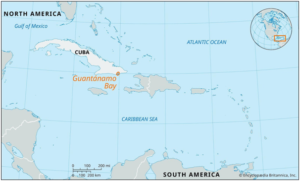
Source: https://indianexpress.com/article/world/trump-us-set-up-30000-person-migrant-detention-center-guantanamo-bay-9806764/Incorrect
Solution (c)
Explanation:
Context: US President Donald Trump signed an executive order directing the preparation of a large-scale migrant detention centre at the US naval base in Guantánamo Bay, Cuba.
- Guantánamo Bay is located in the Caribbean Sea. It forms an inlet of the Caribbean Sea, indenting southeastern Cuba. Hence option c is correct.
- It is a large and well-sheltered bay, it has a narrow entrance to a harbour and is capable of accommodating large vessels.
- It is served by the ports of Caimanera and Boquerón.

Source: https://indianexpress.com/article/world/trump-us-set-up-30000-person-migrant-detention-center-guantanamo-bay-9806764/ -
Question 25 of 35
25. Question
With reference to the Nicobarese Tribe, consider the following statements:
- They live on the Nicobar Islands in the Bay of Bengal, part of India’s Andaman and Nicobar Islands Union Territory.
- They belong to the Mongoloid ethnic group.
- They practice a matriarchal joint family system known as Tuhet.
Select the correct answer using the codes below:
Correct
Solution (a)
Explanation:
Context: Scientists from India have reported finding the genetic heritage of the people of the Nicobar Archipelago in the Indian Ocean.
- The Nicobarese Tribe lives on the Nicobar Islands in the Bay of Bengal, part of India’s Andaman and Nicobar Islands Union Territory. Hence statement 1 is correct.
- They belong to the Mongoloid ethnic group. Hence statement 2 is correct.
- They are classified into six territorial groups: Car Nicobar, Chowra, Teressa with Bompoka, Central Group, Southern Group, and the Shompen (the inland tribe of Great Nicobar).
- They practice a patriarchal joint family system known as Tuhet. Hence statement 3 is incorrect.
- They do not have individual ownership, the Tuhet collectively own land, coconut trees, and pigs.
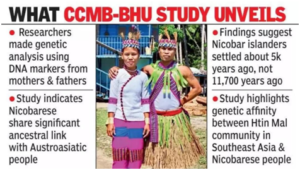
Source: https://www.thehindu.com/sci-tech/science/new-study-decodes-when-the-nicobarese-people-came-to-the-island/article69142834.eceIncorrect
Solution (a)
Explanation:
Context: Scientists from India have reported finding the genetic heritage of the people of the Nicobar Archipelago in the Indian Ocean.
- The Nicobarese Tribe lives on the Nicobar Islands in the Bay of Bengal, part of India’s Andaman and Nicobar Islands Union Territory. Hence statement 1 is correct.
- They belong to the Mongoloid ethnic group. Hence statement 2 is correct.
- They are classified into six territorial groups: Car Nicobar, Chowra, Teressa with Bompoka, Central Group, Southern Group, and the Shompen (the inland tribe of Great Nicobar).
- They practice a patriarchal joint family system known as Tuhet. Hence statement 3 is incorrect.
- They do not have individual ownership, the Tuhet collectively own land, coconut trees, and pigs.

Source: https://www.thehindu.com/sci-tech/science/new-study-decodes-when-the-nicobarese-people-came-to-the-island/article69142834.ece -
Question 26 of 35
26. Question
Consider the following statements:
Statement I: Plants with mining dust on their leaves are exacerbating global warming over time.
Statement II: It is because plants with mining dust on their leaves absorb 2-3 grams less carbon per square meter compared to dust-free plants by significantly contributing to higher levels of carbon dioxide in the atmosphere.
Which one of the following is correct with respect to the above statements?
Correct
Solution (a)
Explanation:
Context: A new study has found that plants with one gram of mining dust on their leaves absorbed around 2-3 grams less carbon per square metre.
- Plants with mining dust on their leaves are exacerbating global warming over time. Hence statement 1 is correct.
- It is because plants with mining dust on their leaves absorb 2-3 grams less carbon per square meter compared to dust-free plants by significantly contributing to higher levels of carbon dioxide in the atmosphere. Hence statement 2 is correct.
- The accumulation of dust on leaves obstructs the stomata, which affects photosynthesis and water vapor release. This reduction in transpiration can cause plants to overheat, leading to stunted growth, plant death, and damage to local ecosystems.
Source: https://www.thehindu.com/sci-tech/energy-and-environment/in-odisha-coal-dust-is-clogging-leaves-and-blocking-carbon-uptake/article69142777.ece
Incorrect
Solution (a)
Explanation:
Context: A new study has found that plants with one gram of mining dust on their leaves absorbed around 2-3 grams less carbon per square metre.
- Plants with mining dust on their leaves are exacerbating global warming over time. Hence statement 1 is correct.
- It is because plants with mining dust on their leaves absorb 2-3 grams less carbon per square meter compared to dust-free plants by significantly contributing to higher levels of carbon dioxide in the atmosphere. Hence statement 2 is correct.
- The accumulation of dust on leaves obstructs the stomata, which affects photosynthesis and water vapor release. This reduction in transpiration can cause plants to overheat, leading to stunted growth, plant death, and damage to local ecosystems.
Source: https://www.thehindu.com/sci-tech/energy-and-environment/in-odisha-coal-dust-is-clogging-leaves-and-blocking-carbon-uptake/article69142777.ece
-
Question 27 of 35
27. Question
Consider the following books:
- The Story of My Experiments with Truth
- Hind Swaraj
- Truth is God
- The Orion
- My Religion
How many of the above-given book/s is/are authored by Mahatma Gandhi?
Correct
Solution (c)
Explanation:
Context: Martyrs’ Day is held yearly in India in honour of the sacrifices made by the individuals who sacrificed their lives for the freedom of the country. This day is especially noteworthy since it pays tribute to the death anniversary of Mahatma Gandhi, the leader of India’s nonviolent freedom struggle.
Books authored by Mahatma Gandhi are:
- The Story of My Experiments with Truth
- Hind Swaraj
- Truth is God
- My Religion
Hence option c is correct.
Note:
The Orion, Gita Rahasya, and The Arctic Home in Vedas are books authored by Bal Gangadhar Tilak.
Source: https://indianexpress.com/article/when-is/mahatma-gandhi-death-anniversary-2025-date-history-significance-martyrs-day-9806921/
Incorrect
Solution (c)
Explanation:
Context: Martyrs’ Day is held yearly in India in honour of the sacrifices made by the individuals who sacrificed their lives for the freedom of the country. This day is especially noteworthy since it pays tribute to the death anniversary of Mahatma Gandhi, the leader of India’s nonviolent freedom struggle.
Books authored by Mahatma Gandhi are:
- The Story of My Experiments with Truth
- Hind Swaraj
- Truth is God
- My Religion
Hence option c is correct.
Note:
The Orion, Gita Rahasya, and The Arctic Home in Vedas are books authored by Bal Gangadhar Tilak.
Source: https://indianexpress.com/article/when-is/mahatma-gandhi-death-anniversary-2025-date-history-significance-martyrs-day-9806921/
-
Question 28 of 35
28. Question
Consider the following statements about the National Critical Mineral Mission:
- To secure India’s critical mineral supply chain.
- To ensure mineral availability from domestic and foreign sources.
- To strengthen the value chains by enhancing technological, regulatory, and financial ecosystems.
- To foster innovation, skill development, and global competitiveness in mineral exploration, mining, beneficiation, processing, and recycling.
How many of the above-given statement/s is/are objectives of the National Critical Mineral Mission?
Correct
Solution (d)
Explanation:
Context: The government approved a ₹16,300-crore National Critical Mineral Mission, envisaging a total outlay of ₹34,300 crore spread over seven years, to achieve self-reliance and accelerate India’s journey towards green energy transition.
The National Critical Mineral Mission (NCCM) will be implemented under the Ministry of Mines for a period from FY 2024-25 to 2030-31.
Objectives of NCCM:
- To secure India’s critical mineral supply chain.
- To ensure mineral availability from domestic and foreign sources.
- To strengthen the value chains by enhancing technological, regulatory, and financial ecosystems.
- To foster innovation, skill development, and global competitiveness in mineral exploration, mining, beneficiation, processing, and recycling.
Hence option d is correct.
Source: https://www.thehindu.com/news/national/government-approves-national-critical-minerals-mission-with-outlay-of-34300-crore-in-7-years/article69154754.ece
Incorrect
Solution (d)
Explanation:
Context: The government approved a ₹16,300-crore National Critical Mineral Mission, envisaging a total outlay of ₹34,300 crore spread over seven years, to achieve self-reliance and accelerate India’s journey towards green energy transition.
The National Critical Mineral Mission (NCCM) will be implemented under the Ministry of Mines for a period from FY 2024-25 to 2030-31.
Objectives of NCCM:
- To secure India’s critical mineral supply chain.
- To ensure mineral availability from domestic and foreign sources.
- To strengthen the value chains by enhancing technological, regulatory, and financial ecosystems.
- To foster innovation, skill development, and global competitiveness in mineral exploration, mining, beneficiation, processing, and recycling.
Hence option d is correct.
Source: https://www.thehindu.com/news/national/government-approves-national-critical-minerals-mission-with-outlay-of-34300-crore-in-7-years/article69154754.ece
-
Question 29 of 35
29. Question
With regard to Contract Farming, consider the following statements:
- It helps firms reduce costs, boost efficiency, and meet demand for high-value, non-traditional crops.
- Small farmers often lack bargaining power with large agribusinesses which may lead to exploitative terms.
- It can create situations of forced cultivation and indirect land grabs by firms.
- It reduces wastage of perishables ensuring fair pricing for producers and consumers.
How many of the above statement/s is/are advantages of Contract Farming?
Correct
Solution (b)
Explanation:
Context: Contract farming works well, as there is no uncertainty over the price or marketing of our produce. We can focus on production and improving crop yield as well as quality.
Contract farming is a system where farmers and buyers agree on the production and marketing of farm products.
Advantages of Contract Farming:
- It helps firms reduce costs, boost efficiency, and meet demand for high-value, non-traditional crops. Hence statement 1 is correct.
- It reduces wastage of perishables ensuring fair pricing for producers and consumers. Hence statement 4 is correct.
- It benefits farmers from credit, inputs, and extension services provided by contracting firms for improved quality and production.
- Contract farmers often earn higher incomes than non-contract farmers due to improved yields, guaranteed prices, and efficient practices.
- It cuts intermediaries, offering better prices for consumers and competitive rates for products without middlemen markups.
Concerns regarding Contract Farming:
- Small farmers often lack bargaining power with large agribusinesses which may lead to exploitative terms. Hence statement 2 is incorrect.
- It can create situations of forced cultivation and indirect land grabs by firms. Hence statement 3 is incorrect.
- Farmers may default if market prices rise, while firms may refuse procurement after a price crash, leaving farmers without a market.
- It can harm the environment through excessive water use, monocropping-related infestations, and increased pesticide and fertilizer application.
- Farmers might prioritize high-value cash crops for contract farming at the cost of growing food crops, affecting local food security.
Source: https://indianexpress.com/article/explained/explained-economics/french-fries-export-contract-farming-win-win-9787669/
Incorrect
Solution (b)
Explanation:
Context: Contract farming works well, as there is no uncertainty over the price or marketing of our produce. We can focus on production and improving crop yield as well as quality.
Contract farming is a system where farmers and buyers agree on the production and marketing of farm products.
Advantages of Contract Farming:
- It helps firms reduce costs, boost efficiency, and meet demand for high-value, non-traditional crops. Hence statement 1 is correct.
- It reduces wastage of perishables ensuring fair pricing for producers and consumers. Hence statement 4 is correct.
- It benefits farmers from credit, inputs, and extension services provided by contracting firms for improved quality and production.
- Contract farmers often earn higher incomes than non-contract farmers due to improved yields, guaranteed prices, and efficient practices.
- It cuts intermediaries, offering better prices for consumers and competitive rates for products without middlemen markups.
Concerns regarding Contract Farming:
- Small farmers often lack bargaining power with large agribusinesses which may lead to exploitative terms. Hence statement 2 is incorrect.
- It can create situations of forced cultivation and indirect land grabs by firms. Hence statement 3 is incorrect.
- Farmers may default if market prices rise, while firms may refuse procurement after a price crash, leaving farmers without a market.
- It can harm the environment through excessive water use, monocropping-related infestations, and increased pesticide and fertilizer application.
- Farmers might prioritize high-value cash crops for contract farming at the cost of growing food crops, affecting local food security.
Source: https://indianexpress.com/article/explained/explained-economics/french-fries-export-contract-farming-win-win-9787669/
-
Question 30 of 35
30. Question
Consider the following pairs:
Toxic proteins in snake venom Function - Haemotoxins
Destroys blood cells - Neurotoxins
Block nerve signals - Cytotoxins
dissolve tissue at the bite site How many pair/s is/are correctly matched?
Correct
Solution (c)
Explanation:
Context: About 58,000 Indians die every year from venomous snakebite, a terrible number that renders India the ‘snakebite capital’ of the world and highlights the scale of this preventable crisis.
Toxic proteins in snake venom Function - Haemotoxins
Destroys blood cells - Neurotoxins
Block nerve signals - Cytotoxins
dissolve tissue at the bite site Hence option c is correct.
Source: https://www.thehindu.com/sci-tech/energy-and-environment/why-are-antivenoms-not-easily-accessible-in-india/article69123152.ece#:~:text=The%20high%20cost%20of%20manufacturing,of%20targeted%20research%20and%20innovation
Incorrect
Solution (c)
Explanation:
Context: About 58,000 Indians die every year from venomous snakebite, a terrible number that renders India the ‘snakebite capital’ of the world and highlights the scale of this preventable crisis.
Toxic proteins in snake venom Function - Haemotoxins
Destroys blood cells - Neurotoxins
Block nerve signals - Cytotoxins
dissolve tissue at the bite site Hence option c is correct.
Source: https://www.thehindu.com/sci-tech/energy-and-environment/why-are-antivenoms-not-easily-accessible-in-india/article69123152.ece#:~:text=The%20high%20cost%20of%20manufacturing,of%20targeted%20research%20and%20innovation
-
Question 31 of 35
31. Question
Passage – 1
Success often emerges from the crucible of setbacks, revealing the symbiotic relationship between achievement and the lessons learned through failure. Every triumph bears the silent scars of past challenges, and every setback carries the potential for growth and resilience. Understanding life allows for a holistic perspective, encouraging an embrace of both light and shadow. It’s a reminder that growth often sprouts from the soil of challenges and that every peak is preceded by a valley. In navigating this we find wisdom in accepting both sides, forging a path that acknowledges the intricate beauty of life’s dualities.
Q.31) Which of the following statements best reflects the logical inference from the passage given above?
Correct
Solution (c)
Explanation
Option (a) is incorrect: The passage is not about the patience for achieving success. It shows two sides of life in various scenarios like “…every peak is preceded by a valley” and “Every triumph bears the silent scars of past.” So, this option does not reflect the logical inference from the passage.
Option (b) is incorrect: This option is about perseverance and wisdom, but the passage just shows two different sides in various aspects of life. So, this is not the best inference from the passage.
Option (c) is correct: The given passage discusses the two sides of life in different conditions like “Every triumph bears the silent scars of past challenges, and every setback carries the potential for growth and resilience. Understanding life allows for a holistic perspective, encouraging an embrace of both light and shadow.” These lines show that life is a coin wherein success and failure are two sides of the same coin. So, this option is the most logical inference.
Option (d) is incorrect: The passage does not mention knowledge as the ultimate objective of life. Therefore, this answer option is incorrect.
Incorrect
Solution (c)
Explanation
Option (a) is incorrect: The passage is not about the patience for achieving success. It shows two sides of life in various scenarios like “…every peak is preceded by a valley” and “Every triumph bears the silent scars of past.” So, this option does not reflect the logical inference from the passage.
Option (b) is incorrect: This option is about perseverance and wisdom, but the passage just shows two different sides in various aspects of life. So, this is not the best inference from the passage.
Option (c) is correct: The given passage discusses the two sides of life in different conditions like “Every triumph bears the silent scars of past challenges, and every setback carries the potential for growth and resilience. Understanding life allows for a holistic perspective, encouraging an embrace of both light and shadow.” These lines show that life is a coin wherein success and failure are two sides of the same coin. So, this option is the most logical inference.
Option (d) is incorrect: The passage does not mention knowledge as the ultimate objective of life. Therefore, this answer option is incorrect.
-
Question 32 of 35
32. Question
Passage – 2
The times of war conflict require leaders to make swift, strategic decisions under intense pressure. While innate traits like resilience and adaptability contribute, structured training cultivates the skills needed to navigate the complexities of warfare. Military leaders undergo rigorous training to hone tactical acumen, strategic thinking, and the ability to inspire and lead troops. The synthesis of inherent leadership qualities and the discipline acquired through training forges commanders capable of navigating the turbulent landscape of war, steering their teams through adversity with courage, precision, and a profound sense of responsibility.
Q.32) Which of the following statements best reflects the crux of the passage?
Correct
Solution (b)
Explanation
Option (a) is incorrect: The passage shows how leadership is helpful in handling wars. However, this option states the other way round – war as essential to learn leadership qualities, which is not correct. So, this option is not the best crux of the passage.
Option (b) is correct: The given passage is about leadership and how it helps in handling war scenarios. Leadership can be inherent or learned through training. The idea that such a unique blend of leadership is helpful in handling wars is visible in the lines “While innate traits like resilience and adaptability contribute, structured training cultivates the skills needed to navigate the complexities of warfare.” Hence, this option best reflects the crux of the passage.
Option (c) is incorrect: The passage is about learning/ acquiring leadership skills for wars. The line “…structured training cultivates the skills needed to navigate the complexities of warfare” suggests that training could be imparted externally. Therefore, it would be incorrect to say that leadership can ‘only’ be self-acquired; it can also be externally taught. Therefore, this answer option is incorrect.
Option (d) is incorrect: The given option compares the two kinds of leaderships which is not discussed in the passage. The main theme of the passage is not the comparison of war-experienced leadership and the leadership acquired through training. So, this is not the best crux of the passage.
Incorrect
Solution (b)
Explanation
Option (a) is incorrect: The passage shows how leadership is helpful in handling wars. However, this option states the other way round – war as essential to learn leadership qualities, which is not correct. So, this option is not the best crux of the passage.
Option (b) is correct: The given passage is about leadership and how it helps in handling war scenarios. Leadership can be inherent or learned through training. The idea that such a unique blend of leadership is helpful in handling wars is visible in the lines “While innate traits like resilience and adaptability contribute, structured training cultivates the skills needed to navigate the complexities of warfare.” Hence, this option best reflects the crux of the passage.
Option (c) is incorrect: The passage is about learning/ acquiring leadership skills for wars. The line “…structured training cultivates the skills needed to navigate the complexities of warfare” suggests that training could be imparted externally. Therefore, it would be incorrect to say that leadership can ‘only’ be self-acquired; it can also be externally taught. Therefore, this answer option is incorrect.
Option (d) is incorrect: The given option compares the two kinds of leaderships which is not discussed in the passage. The main theme of the passage is not the comparison of war-experienced leadership and the leadership acquired through training. So, this is not the best crux of the passage.
-
Question 33 of 35
33. Question
The average monthly income of Ananya for the first 9 months of a year was Rs. 12000, while her average monthly income for the last 3 months of that year was Rs. 16000. Find her average monthly income (in Rs.) for that year.
Correct
Solution (b)
Explanation
Average monthly income of Ananya for that year = [9(12000) + 3(16000)]/12 = Rs. 13000
Hence, option (b) is the right answer.
Incorrect
Solution (b)
Explanation
Average monthly income of Ananya for that year = [9(12000) + 3(16000)]/12 = Rs. 13000
Hence, option (b) is the right answer.
-
Question 34 of 35
34. Question
A certain code is prepared such that two letters are skipped in between any two adjacent letters. Which of the following series may be an output of this coding technique?
Correct
Solution (a)
Explanation
We need to check all the options to see which of the codes follow the given rule.
Option (a): M +2→ P +2 → S +2 →V +2 →Y +2 →B +2 →E (follows the rule)
Option (b): Q +2 → T (does not follow the rule)
Option (c): E +2 →H (does not follow the rule)
Option (d): Z +2 →C +2 → F (does not follow the rule) Hence, option (a) is the correct answer.
Incorrect
Solution (a)
Explanation
We need to check all the options to see which of the codes follow the given rule.
Option (a): M +2→ P +2 → S +2 →V +2 →Y +2 →B +2 →E (follows the rule)
Option (b): Q +2 → T (does not follow the rule)
Option (c): E +2 →H (does not follow the rule)
Option (d): Z +2 →C +2 → F (does not follow the rule) Hence, option (a) is the correct answer.
-
Question 35 of 35
35. Question
If ‘BDZBKMLN’ is the code of ‘CALM’, then what will be the code for ‘TABLE’?
Correct
Solution (c)
Explanation
‘BDZBKMLN’ is the code of ‘CALM’
Each letter of the given words is represented by the letter preceding it and the letter following it. (B-C-D), (Z-A-B), (K-L-M), (L-M-N)
Similarly, code for ‘TABLE’ will be:
S-T-U, Z-A-B, A-B-C, K-L-M, D-E-F
Therefore, SUZBACKMDF is the required code. Hence, option (c) is the right answer.
Incorrect
Solution (c)
Explanation
‘BDZBKMLN’ is the code of ‘CALM’
Each letter of the given words is represented by the letter preceding it and the letter following it. (B-C-D), (Z-A-B), (K-L-M), (L-M-N)
Similarly, code for ‘TABLE’ will be:
S-T-U, Z-A-B, A-B-C, K-L-M, D-E-F
Therefore, SUZBACKMDF is the required code. Hence, option (c) is the right answer.
All the Best
IASbaba

